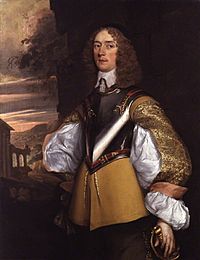Henry Gage (soldier) facts for kids
Quick facts for kids
Sir
Henry Gage
|
|
|---|---|

Portrait by John Weesop
|
|
| Born | 29 August 1597 Haling Park, Surrey |
| Died | 11 January 1645 (aged 47) Oxford |
| Buried | |
| Service/ |
Army of Flanders; Royalist Army |
| Years of service | 1619–1625, 1630–1644; 1644–1645 |
| Rank | Colonel |
| Commands held | Governor of Oxford |
| Battles/wars | Siege of Bergen-op-Zoom (1622), Siege of Breda (1624), Siege of Saint-Omer (1638), Siege of Basing House (1644) |
| Awards | Knight Bachelor |
| Spouse(s) | Mary Daniel |
| Relations | Thomas Gage (clergyman) |
Sir Henry Gage (born August 29, 1597 – died January 11, 1645) was an important officer who fought for the King during the English Civil War.
Contents
Early Life and Education
Henry Gage was born in Haling Park, Surrey. His parents were John Gage and Margaret Copley. His family was Catholic, and they had strong connections to other well-known Catholic families, like that of Sir Thomas More.
When Henry was twelve, he went to a Catholic school in St. Omer, France. This was the English Jesuit College, where he studied from 1609 to 1614.
After that, he spent three years at the English College, Rome (from 1615 to 1618). But Henry decided that becoming a priest was not for him. So, at age 22, he chose to become a professional soldier.
A Soldier in Europe's Wars
In 1619, Henry Gage joined the Army of Flanders, which was the Spanish army in what is now Belgium and the Netherlands. He started as a soldier in Antwerp. By 1622, he became a captain. He showed great bravery during the Siege of Bergen-op-Zoom (1622) and the Siege of Breda (1624). A siege is when an army surrounds a town or fort to try and capture it.
In 1625, he was a captain in another regiment. But when England and Spain went to war, he returned home. He did not want to fight against his own country. During this time, he translated a book about the Siege of Breda into English.
After 1630, he went back to Flanders. He gathered 900 men and became the colonel of his own regiment. He helped break the French Siege of Saint-Omer in 1638.
Henry Gage was known for being very skilled and wise. People said he was one of the few soldiers everyone liked and respected. He was also very religious and went to Mass every day.
Fighting in the English Civil War
When the English Civil War began, King Charles I called for help. Henry Gage gathered weapons and supplies from the Spanish king. He then returned to England and joined the Royalist army at their headquarters in Oxford. On June 11, he captured and set up a military base at Boarstall House.
Helping Basing House
In September 1644, the Royalist soldiers at Basing House needed urgent help. This huge house belonged to the Catholic John Paulet, 5th Marquess of Winchester. It was the largest private home in England, located about 40 miles from Oxford.
Basing House was surrounded by walls and earthworks. It had an old medieval fort and a new, grand house with 380 rooms. In November 1643, William Waller's Parliamentary troops tried to capture it. In June 1644, Colonel Richard Norton started another siege. His heavy cannons caused a lot of damage.
The soldiers inside Basing House asked for help from Oxford. Colonel Henry Gage quickly put together a relief force. They pretended to be Parliamentarians and managed to get into Basing House. They brought much-needed ammunition and food on September 11. Then, they escaped back to Oxford by night, swimming their horses across two rivers. For this brave act, Colonel Gage was made a knight.
Less than two weeks later, Colonel Norton started the siege again. But on November 19, Colonel Gage once more brought help to Basing House. The house was later destroyed by Oliver Cromwell in 1645. Gage also helped lift the siege of Banbury Castle on October 25.
Governor of Oxford
On Christmas Day 1644, the King made Gage the Governor of Oxford. He replaced Sir Arthur Aston. Sadly, Aston became a bitter enemy of Gage.
However, Gage's time as governor was short. The next month, on January 11, 1645, he was badly wounded in a small fight near Abingdon. He died from his injuries. Two days later, he had a grand military funeral at Christ Church Cathedral, Oxford, where he was buried.
His memorial says that he was a brave leader. It mentions his service in many battles in Europe. It also talks about how he brought supplies to the King and helped Basing House twice. He was known for his wisdom, language skills, military fame, loyalty, and love for his King and country.
Family Life
Henry Gage married Mary Daniel. They had six children together: two sons and four daughters.


